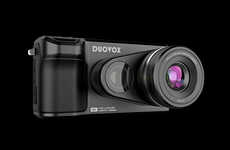
A Team of Researchers Develop a Special Imaging System
Amy Duong — January 27, 2024 — Art & Design
References: journals.plos.org & designtaxi
Vera Vasas from the University of Sussex works with her team at the Hanley Color Lab at George Mason University to develop a unique imaging system. This adds colors to video cameras which are specifically replicated to depict what animals see from their point of view. It gives users a closer understanding of how animals navigate and find their own ways of communication in their natural environments.
Explaining how animals find food and look for a potential mate, Senior author, Daniel Hanley explains “We’ve long been fascinated by how animals see the world. Modern techniques in sensory ecology allow us to infer how static scenes might appear to an animal; however, animals often make crucial decisions on moving targets. Here, we introduce hardware and software tools for ecologists and filmmakers that can capture and display animal-perceived colors in motion.”
Image Credit: Daniel Hanley / PLOS Biology
Explaining how animals find food and look for a potential mate, Senior author, Daniel Hanley explains “We’ve long been fascinated by how animals see the world. Modern techniques in sensory ecology allow us to infer how static scenes might appear to an animal; however, animals often make crucial decisions on moving targets. Here, we introduce hardware and software tools for ecologists and filmmakers that can capture and display animal-perceived colors in motion.”
Image Credit: Daniel Hanley / PLOS Biology
Trend Themes
1. Animal-perspective Video Cameras - The development of animal-perspective video cameras offers a unique way to understand how animals see and perceive their surroundings.
2. Replicating Animal Vision - By replicating animal vision, researchers are able to gain insights into how animals navigate, find food, and communicate in their natural environments.
3. Sensory Ecology Techniques - The use of sensory ecology techniques enables the capture and display of animal-perceived colors in motion, providing valuable information for ecologists and filmmakers.
Industry Implications
1. Research and Development - The research and development industry can explore the potential of animal-perspective video cameras to enhance understanding of animal behavior and perception.
2. Film and Television Production - The film and television production industry can leverage the replication of animal vision to create immersive experiences and storytelling that resonate with viewers.
3. Ecology and Wildlife Conservation - Ecology and wildlife conservation organizations can utilize sensory ecology techniques to gather valuable data on animal behavior and inform conservation efforts.
2.3
Score
Popularity
Activity
Freshness
















